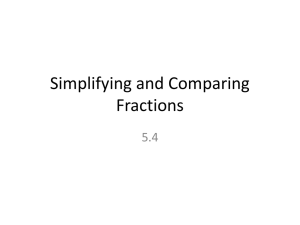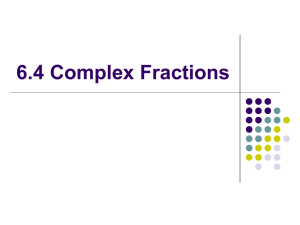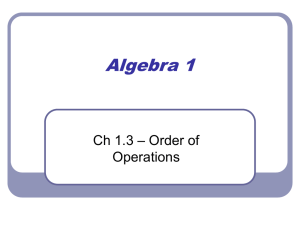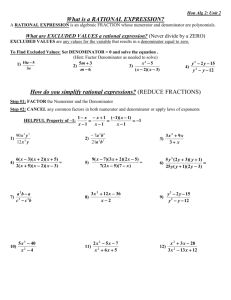Complex fractions ppt - Morgan Park High School
advertisement
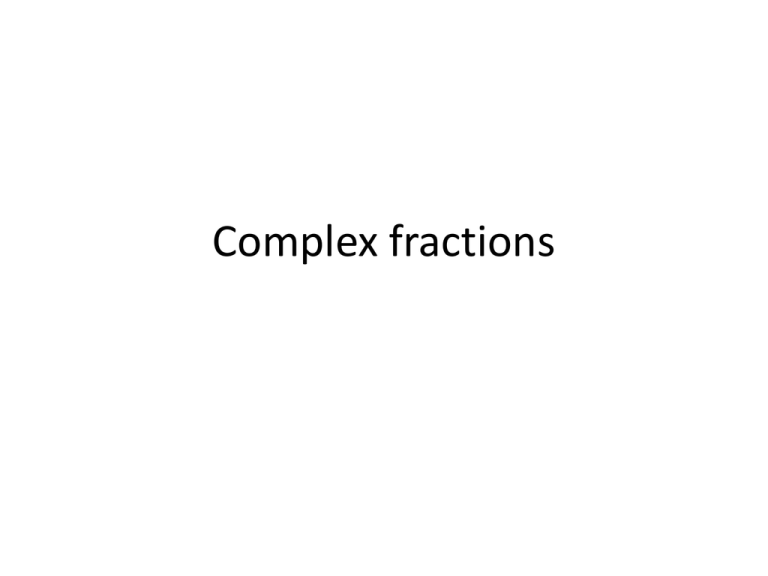
Complex fractions Objective • Simplify complex fractions • Lets Review fraction rules first………….. Multiplying Fractions a c a c , b 0 and d 0 b d bd -5 Multiply 21 · 3 . 4 1 -5 21 · 3 4 = -5 21 7 · 3 4 = -5 7 · 1 4 = -5 28 Multiplying Rational Expressions 1. Factor all numerators and denominators completely. 2. Divide out common factors. 3. Multiply numerators together and multiply denominators together. 2 3 18x y 22z Multiply 2 5. 11z x y 2 36z - 18x y 22z - 18x y 22z 2 5 2 5 4 y 11z x y 11z x y 2 3 2 3 Dividing Two Fractions a c a d ad , b 0 , d 0 and c 0 b d b c bc -2 Divide 9 -2 9 5 9 = -2 9 5 . 9 · 9 5 = -2 9 1 1 · 9 5 = -2 5 Dividing Rational Expressions Invert the divisor (the second fraction) and multiply 1 1 Divide x 2 7x 12 x 2 - 17 30 . 1 1 1 x 2 - 17 30 2 2 2 x 7x 18 x - 17 30 x 7x 18 1 1 (x 2)(x 15) (x 15) (x 9)(x 2) 1 (x 9) Adding/Subtracting Fractions a b a b , c0 c c c Add 5 + 2 . 12 12 5 2 + 12 12 = 7 12 a b a b , c0 c c c Common Denominators 1. Add or subtract the numerators. 2. Place the sum or difference of the numerators found in step 1 over the common denominator. 3. Simplify the fraction if possible. Subtract 2x - 7 6 . 5 5 2x - 7 6 2x - 7 - 6 2x - 13 5 5 5 5 Common Denominators Example: a.) 3w 5 - 2w - 4 2 . Add 2 w 2w 1 w 2w 1 3w 5 - 2w - 4 3w 5 - 2w - 4 2 2 2 w 2w 1 w 2w 1 w 2w 1 w 1 1 3w 5 - 2w - 4 2 2 (w 1) (w 1) w 2w 1 Common Denominators Example: b.) 4x 2 5 x 2 - x 29 Subtract 2 . 2 9x 64 9x 64 4x 2 5 x 2 - x 29 4x 2 5 - (x2 - x 29) 2 2 9x 64 9x 64 9x 2 64 4x 2 5 - x 2 x 29 3x 2 x 24 2 2 9x 64 9x 64 (x 3)(3x 8) (x 3) (3x 8)(3x 8) (3x 8) Unlike Denominators 1. Determine the LCD. 2. Rewrite each fraction as an equivalent fraction with the LCD. 3. Add or subtract the numerators while maintaining the LCD. 4. When possible, factor the remaining numerator and simplify the fraction. Unlike Denominators Example: 3 5 a.) w 2 w The LCD is w(w+2). 3 w 5 w 2 3w 5(w 2) w 2 w w w 2 w (w 2) w (w 2) 3w 5w 10 8w 10 w (w 2) w (w 2) w (w 2) 2(4w 5) 8w 10 and 2 are also acceptable answers. w (w 2) w 2w Unlike Denominators Example: x 1 x 1 The LCD is 12x(x – 1). b.) 4x - 4 3x 4(x - 1) 3x x 3x 1 4(x - 1) 4(x - 1) 3x 3x 4(x - 1) 3x 2 4(x - 1) 3x 2 4x 4 12x(x - 1) 12x(x - 1) 12x(x - 1) This cannot be factored any further. Complex Fractions Simplifying Complex Fractions A complex fraction is one that has a fraction in its numerator or its denominator or in both the numerator and denominator. Example: 4 5 4 x3 x x3 a b a-9 a b So how can we simplify them? • Remember, fractions are just division problems. • We can rewrite the complex fraction as a division problem with two fractions. • This division problem then changes to multiplication by the reciprocal. 5 6 2 3 5 2 6 3 5 3 6 2 5 4 Simplifying Complex Fractions Rule • Any complex fraction a b c d Where b ≠ 0, c ≠ 0, and d ≠ 0, may be expressed as: ad bc What if we have mixed numbers in the complex fraction? • If we have mixed numbers, we treat it as an addition problem with unlike denominators. • We want to be working with two fractions, so make sure the numerator is one fraction, and the denominator is one fraction • Now we can rewrite the complex fraction as a division of two fractions Example 1 2 2 5 Try on your own… 4 1 1 3 What about complex rational expression? • Treat the complex rational expression as a division problem • Add any rational expressions to form rational expressions in the numerator and denominator • Factor • Simplify • “Bad” values Ex. 2: Simplify 1 1 y x x y xy xy 1 1 y x x y xy xy yx xy yx xy 1 x 1 x 1 y . 1 y ← The LCD is xy for both the numerator and the denominator. ← Add to simplify the numerator and subtract to simplify the denominator. y x xy xy y x ← Multiply the numerator by the reciprocal of the denominator. Ex. 2: Simplify y x xy xy y x yx yx 1 x 1 x 1 y . 1 y ← Eliminate common factors. Example 1 x x x 1 1 (x ) (x 1) x x 2 1 1 ( ) x x 1 x 1 (x 1)(x 1) 1 , x 0,1 x x x 1 Example x2 5 6 1 2 x x Try on your own 2 3x 1 x One more for you 16 x x 2 x 8x 16 Ex. 3: Simplify ( x 4)(x 4) 1 x4 ( x 11)(x 3) 48 x 3 1 x4 x4 48 x 11 x 3 ← The LCD of the numerator is x + 4, and the LCD of the denominator is x – 3. Ex. 3: Simplify x 8 x 16 1 x4 2 x 8 x 33 48 x 3 1 x4 x4 48 x 11 x 3 2 ← FOIL the top and don’t forget to subtract the 1 and add the 48 on the bottom. Ex. 3: Simplify x 8 x 15 x4 2 x 8 x 15 x 3 1 x4 x4 48 x 11 x 3 2 ← Simplify by subtracting the 1 in the numerator and adding the 48 in the denominator. Ex. 3: Simplify 1 x4 x4 48 x 11 x 3 x 8 x 15 x 3 2 x4 x 8 x 15 2 ← Multiply by the reciprocal. x2 + 8x +15 is a common factor that can be eliminated. 1 x4 x4 48 x 11 x 3 Ex. 3: Simplify x3 x4 ← Simplify Model Problems 1) 5 3x 1 2x 3) 24 x3 36 x3 5) k k 2 6 k k 2 3 2) y 1 1 y y 4) x y x 1 1 x y 6) 7 1 y2 3 1 y2 Homework • Practice Sheet
